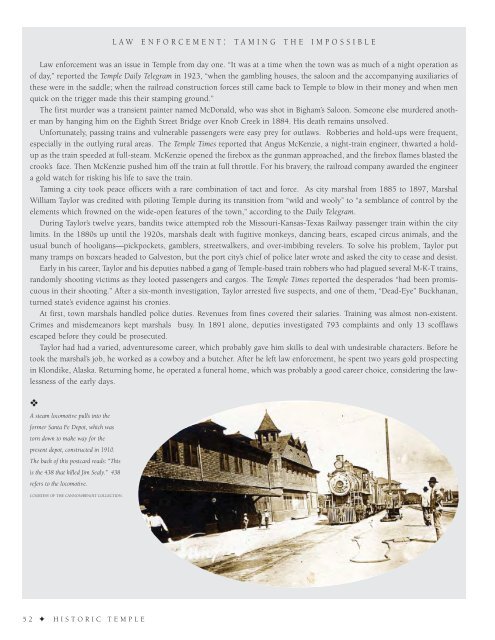Historic Temple
An illustrated history of the city of Temple, Texas, paired with the histories of companies, families and organizations that make the city great.
An illustrated history of the city of Temple, Texas, paired with the histories of companies, families and organizations that make the city great.
Create successful ePaper yourself
Turn your PDF publications into a flip-book with our unique Google optimized e-Paper software.
LAW ENFORCEMENT: TAMING THE IMPOSSIBLE<br />
Law enforcement was an issue in <strong>Temple</strong> from day one. “It was at a time when the town was as much of a night operation as<br />
of day,” reported the <strong>Temple</strong> Daily Telegram in 1923, “when the gambling houses, the saloon and the accompanying auxiliaries of<br />
these were in the saddle; when the railroad construction forces still came back to <strong>Temple</strong> to blow in their money and when men<br />
quick on the trigger made this their stamping ground.”<br />
The first murder was a transient painter named McDonald, who was shot in Bigham’s Saloon. Someone else murdered another<br />
man by hanging him on the Eighth Street Bridge over Knob Creek in 1884. His death remains unsolved.<br />
Unfortunately, passing trains and vulnerable passengers were easy prey for outlaws. Robberies and hold-ups were frequent,<br />
especially in the outlying rural areas. The <strong>Temple</strong> Times reported that Angus McKenzie, a night-train engineer, thwarted a holdup<br />
as the train speeded at full-steam. McKenzie opened the firebox as the gunman approached, and the firebox flames blasted the<br />
crook’s face. Then McKenzie pushed him off the train at full throttle. For his bravery, the railroad company awarded the engineer<br />
a gold watch for risking his life to save the train.<br />
Taming a city took peace officers with a rare combination of tact and force. As city marshal from 1885 to 1897, Marshal<br />
William Taylor was credited with piloting <strong>Temple</strong> during its transition from “wild and wooly” to “a semblance of control by the<br />
elements which frowned on the wide-open features of the town,” according to the Daily Telegram.<br />
During Taylor’s twelve years, bandits twice attempted rob the Missouri-Kansas-Texas Railway passenger train within the city<br />
limits. In the 1880s up until the 1920s, marshals dealt with fugitive monkeys, dancing bears, escaped circus animals, and the<br />
usual bunch of hooligans—pickpockets, gamblers, streetwalkers, and over-imbibing revelers. To solve his problem, Taylor put<br />
many tramps on boxcars headed to Galveston, but the port city’s chief of police later wrote and asked the city to cease and desist.<br />
Early in his career, Taylor and his deputies nabbed a gang of <strong>Temple</strong>-based train robbers who had plagued several M-K-T trains,<br />
randomly shooting victims as they looted passengers and cargos. The <strong>Temple</strong> Times reported the desperados “had been promiscuous<br />
in their shooting.” After a six-month investigation, Taylor arrested five suspects, and one of them, “Dead-Eye” Buckhanan,<br />
turned state’s evidence against his cronies.<br />
At first, town marshals handled police duties. Revenues from fines covered their salaries. Training was almost non-existent.<br />
Crimes and misdemeanors kept marshals busy. In 1891 alone, deputies investigated 793 complaints and only 13 scofflaws<br />
escaped before they could be prosecuted.<br />
Taylor had had a varied, adventuresome career, which probably gave him skills to deal with undesirable characters. Before he<br />
took the marshal’s job, he worked as a cowboy and a butcher. After he left law enforcement, he spent two years gold prospecting<br />
in Klondike, Alaska. Returning home, he operated a funeral home, which was probably a good career choice, considering the lawlessness<br />
of the early days.<br />
❖<br />
A steam locomotive pulls into the<br />
former Santa Fe Depot, which was<br />
torn down to make way for the<br />
present depot, constructed in 1910.<br />
The back of this postcard reads: “This<br />
is the 438 that killed Jim Sealy.” 438<br />
refers to the locomotive.<br />
COURTESY OF THE CANNON/BENOIT COLLECTION.<br />
52 ✦ HISTORIC TEMPLE
















